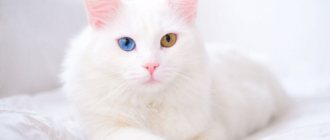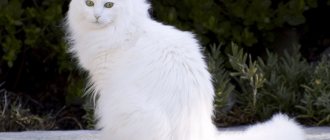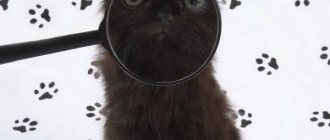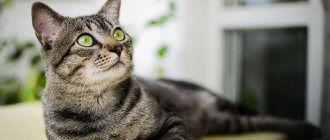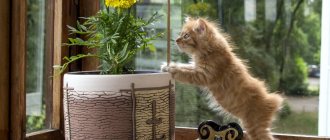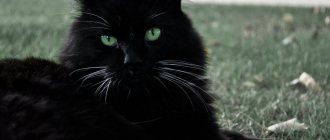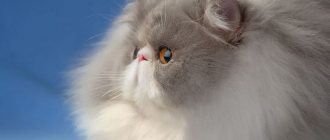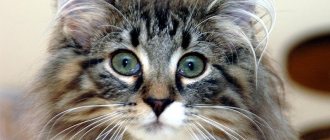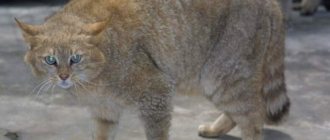Video
* We invite you to watch a video about the Turkish Angora . In fact, in front of you is a playlist in which you can select and watch any of 20 videos about a given cat breed by simply clicking on the button in the upper right corner of the window. In addition, the material contains quite a lot of photos. By looking at them you can find out what a Turkish Angora looks like.
Rate the material!
[Total votes: 3 Average: 3]
With long, silky fur and a fluffy tail, slender paws and multi-colored eyes, the Turkish Angora is so beautiful that it seems as if it has just stepped out of the pages of a fairy tale book. Her beautiful appearance is perfectly matched by her royal stature and grace, as well as her dog's devotion to her master. Thanks to a considerable number of positive qualities, the Turkish Angora has earned enormous popularity among cat lovers.
History of the origin of Turkish Angoras
Turkish Angoras are incredibly beautiful, graceful and intelligent cats that long ago attracted the attention of the people of the Middle East and became their noble favorites. It is assumed that the ancestors of these cats were their wild Middle Eastern counterparts, which were especially numerous in the vicinity of modern Ankara in Turkey.
According to one legend, the Prophet Muhammad had a favorite cat, Mueza, with eyes of different colors, white fur and a fluffy tail. No animal had the right to enter the mosque, and only she was allowed to do so. It is believed that this cat was of the Angora breed.
Interesting fact: In Turkey, these cats were often given as gifts for significant family events (weddings, birth of an heir), as well as to ambassadors of other states as a sign of special respect. Angora cats have also been popular pets in the homes of rulers in the Middle East for centuries.
In Europe, the first representatives of this breed appeared during the Crusades, and with the beginning of active trade with the Ottoman Empire (16th century), cats were presented to European monarchs, who earned special favor from eastern rulers. It was the merchants who delivered them to Europe. Gradually, white fluffy Angora cats settled in almost all the royal courts of Europe. Turkish Angoras were brought to Russia a little later - during the Russian-Turkish wars.
The British fell in love with Angora cats, began to breed them, and already at the end of the 19th century began to present them at exhibitions. In the homeland of cats - in Turkey, unfortunately, no one was breeding cats for quite a long time, and their population gradually became very small. The situation changed radically in the 20s of the last century, when Angora cats began to be bred in one of the zoos in Ankara. Around the same time, these beautiful cats were given national treasure status, which prohibited their export from the country.
The ban was somewhat relaxed only 40 years later (in the 60s), but with one condition - obtaining special permission from the authorities to export the Angora cat. Few managed to obtain permission. Among them were the wives of two American diplomats, thanks to whom Turkish Angoras came to the United States, where no one was indifferent to their beauty.
History of the origin of the breed
The Angora cat is a representative of the Middle Eastern wild cat. This breed was first discovered in the 16th century. The Angora cat breed originated in Turkey and was named after the capital Ankara, formerly called Angora.
The Turkish Angora cat breed became famous thanks to Mustafa Kamal Ataturk. The Turkish prophet predicted that his successor would be the man who would be bitten by the odd-eyed cat.
Since then, the Turkish woman has become respectful to the Arabs and an Angora cat with different eye colors can easily visit the mosque. Representatives of the breed came to Europe as gifts from the Turkish Shahs.
Genetic studies have shown that the Angora is a native breed and its roots come from a short-haired, ancient cat. The short-haired Angora cat was brought from Turkey to Africa, where it was domesticated.
In 1917, Turkish Angoras became less popular as the Persian variety was introduced.
Turkish Angora - description of the breed
The Turkish Angora is not a very big cat. However, it looks much larger than its actual size thanks to its long fur, slender limbs and long fluffy tail. According to breed standards, the height of the Turkish Angora at the withers is approximately 35 cm. At the same time, the male weighs no more than 5 kg, and the female weighs no more than 3 kg.
The cat's physique is fit, slender, elongated. A medium-sized head in the shape of a wedge or triangle is set on a graceful and sophisticated neck. The cat's eyes are quite large, slightly slanted, one might even say almond-shaped, like a real oriental beauty. The iris of the eyes comes in a variety of colors, and it is not uncommon for the same animal to have eyes of different colors. The ears are also large, set high, pointed and with small tufts at the tips.
The Turkish Angora's coat is long, very soft and silky, and has virtually no undercoat. It is most elongated in the neck, chest, hind legs, and between the toes. On the back of the cat there is a so-called cloak, consisting of long guard hairs. It is worth noting that all guard hairs have a hollow structure, which undoubtedly helps the animal feel quite comfortable in both hot and cool conditions. The color of the coat of these cats is quite varied, but the most valuable is the pure white color.
The tail of this cat is worthy of a separate description. In its length it can compete with the length of the entire body of a cat, and in appearance it resembles a peacock feather.
Appearance of Turkish Angora
The Turkish Angora is an elegant medium-sized cat. The flexible, elongated body is quite muscular and graceful. Females weigh 2.5-3.5 kg, males can be 2 times larger. When assessing, experts pay more attention to the balance of the physique than to the size of the animal.
Head
A flat skull and high cheekbones form a wedge-shaped head with a smooth silhouette. The forehead gently turns into a straight nose. The rounded chin in profile is perpendicular to the nose.
Eyes
Large, set wide, have a rounded, slightly oblique shape. Usually blue, green or yellow in color, individuals with differently colored eyes are often found.
Ears
Large, high-set ears have a wide base and are positioned vertically. There is a thick “brush” of fur inside, with small tassels at the ends.
Neck
The pronounced graceful neck of the Turkish Angora is of medium length.
Body
Small, fit and slender. The croup is slightly higher than the shoulders.
Legs
Slender and tall. The hind limbs are slightly longer than the forelimbs. It is desirable that there are characteristic tufts of fur between the toes.
Tail
Fluffy, almost as long as the body, tapering to a wedge-shaped tip.
Wool
The semi-long coat of the Turkish Angora is very soft, crumbly, with practically no undercoat. In the area of the “pants” and collar, the hair is slightly longer than on the rest of the body.
Color
Until today, snow-white Angora cats are in favor, but cream, brown, tabby, smoky, and red colors are also considered acceptable.
Popular colors of Turkish Angoras
In the homeland of Angora cats - in Turkey, as well as in Russia, Britain and the USA, it is generally accepted that the snow-white coat color is characteristic and original for this breed. In this case, the animal’s nose and paw pads should be pink.
Such an erroneous opinion arose for the simple reason that pure white Turkish Angoras are most common today. Probably, many will be extremely surprised, but these cats acquired white coat color not so long ago - in the middle of the last century, when it occurred to one of the breeders to bet on this color. Many people took up the idea and as a result, many pure white Angora cats appeared in the world.
Today, the Turkish Angora cat breed is characterized by the following shades of wool:
- Cream;
- Red;
- Light blue;
- Black or blue smoky;
- Marble, brindle, marbled, patchwork, silver, brown, blue, red, cream tabby;
- Chintz and light chintz;
- Tortoiseshell;
- Bluish cream;
- White black;
- White-red;
- White and blue;
- White-cream.
Such a variety of colors of Angora cats were first recognized not in their homeland, but in the USA. Without thinking twice, other countries followed this example, with Turkey almost last on the list.
Interesting fact: It is worth noting that over the past centuries the appearance of cats has not changed much, but, as already mentioned, bright white Angoras are the most common. At the same time, the most valuable are considered to be individuals whose ancestry comes specifically from Turkey.
On top of that, as a bonus, the Creator awarded the Turkish Angora with six, which never gets confused and practically does not shed.
Description and accepted standards
This breed has long slender legs. The eyes should be almond-shaped. The Turkish cat must have:
- Head. Can be of different sizes, from small to medium, depending on body size. The shape is in the form of a regular wedge, of medium length. The profile has two planes formed by the top of the head and the nose line, which intersects above eye level.
- Muzzle. It is a continuation of the wedge lines; there should be no bulges.
- Ears. Large, with a wide base, sharp tips, and a little fluff on the inner surface.
- Eyes. Large in size, almond-shaped, slightly slanted, wide open. Eye color does not depend on coat color and can be of any color.
- Nose. Should be of medium length.
- Neck. slender, thin, long.
- Chin. Curved and strong.
- Body. It is of medium size and correct proportions. The skeleton is strong, the body itself is long and slender. The sacrum is located above the line of the shoulders.
- Legs. The rear ones should be longer than the front ones.
- Tail. Long, pointed with a wide base and narrow end.
The hind legs may look like pants. The balance of the physique should be proportional. The presence of disproportions in physique is not allowed; stocky individuals, with kinks in the tail, and with pronounced strabismus are subject to disqualification. The size and weight of Angora cats correspond to medium-sized cats - 3.5-5 kg. The table below shows the weight of kittens of this breed from one month to two years.
Turkish Angora weight table by month.
Material on the topic: popular colors of the Scottish cat breed.
Coat colors and features
This breed has a guard coat and no undercoat. The length of the hair varies along the length of the animal. On the collar and tail it is longer and silky. The color of the coat can be very different:
- White. The white angora is the most common cat. The color should be uniform, without any inclusions.
- Black. It has a coal-black, shiny hue. The color is uniform along the entire length of the hair. The leather is also painted black.
- Blue. It can be blue or lighter shades. The shade should be uniform over the entire surface.
- Cream. The shade is even, without spots or inclusions. Light shades are more preferable.
- Red. The color is deep and rich. No shading or marks.
- Smoky black. Has a white undercoat. Outwardly, the cat looks black, but when it moves, white fur is visible.
- Smoky blue. Similar to black smoke.
- Tabby. The drawing is expressed against a general background. There is a clear letter M on the forehead.
There may be other colors besides chocolate, lilac or Himalayan colors or their combinations with white.
Black and white Angora cat.
Red Angora cat
Red and white colors
Breed subspecies
There are different subspecies that have different standards established by international felinological standards - WCF, CFA, TICA, FIFE.
Character and habits of Turkish Angoras
Angora cats are very smart, reserved, intelligent, wise, affectionate and active pets. At the same time, they are incredibly patient and accommodating, which allows them to get along well not only with adults and children, but even with dogs.
These are cats with an easy disposition: sociable, but at the same time unobtrusive. When they get into a family as a kitten, Turkish Angoras often choose one owner and obey only him. The devotion of these cats knows no bounds and is in some ways comparable to that of a dog.
These cats are never shy - they are always close to their owners. Even if guests come to the house, the Angora cat will not hide somewhere in a secluded corner, but will definitely come out to see who came there, get acquainted with everyone and show itself in all its glory.
Interesting fact: The intelligence of Angora cats is worthy of special attention. It allows animals to remember almost all of the owner’s movements: how cabinets, doors and even the refrigerator open in the house.
Tenacity is another characteristic trait of Turkish Angoras. If a cat wants to play, and the owner suddenly takes away a toy from her, she will trace where it was hidden and then she will definitely find this object, pull it out and continue playing with it. It is also common for these animals to remember the voices of their owners and distinguish among them the voices of their favorites.
These cats are also very playful, and at any age, even very old ones. Therefore, toys should always be available in the house. In games, animals love to demonstrate their extreme agility and jumping.
Interesting facts about Turkish Angoras
Angora cats, like no other, are prone to heterochromia - different colors of the iris of the eye. The reason for this phenomenon is the increased or decreased content of melanin in the iris of the eye. Heterochromia is more common in animals (dogs, cats) than in people. Because of it, one eye may be blue, and the other green, yellow or brown.
Angora cats are often very talkative, and their manner of speech is quite unusual and somewhat specific. Of course, they also know how to meow, but they rarely do it. Most often, these cats purr inwardly without opening their mouths, and thus manage to convey the entire spectrum of emotions: from pleasure to irritation and anger.
Thanks to its excellent health, this breed is the longest-living cat, often living up to 20 years or more.
Turkish Angoras are true hunters to the core and the tip of their tail. Since ancient times, they have had a reputation as excellent mousecatchers. Also, thanks to their innate ability to jump, they can catch birds in flight and do this at any opportunity. Therefore, when keeping such cats in city apartments, where there is absolutely no opportunity to hunt, their owners must provide them with daily games. Rubber or plush balls, as well as imitations of rodents and birds, are suitable as toys.
These cats, more than their other counterparts, love to climb somewhere higher (on a table, on a cabinet) and from there watch what is happening below.
Angora cats are usually very obedient and intelligent. Therefore, if it is clear to them that something cannot be done, they will never violate the prohibition.
The Turkish Angora has many dog-like traits. For example, they quickly learn various tricks and commands: they bring a ball or other objects in their mouths to the owner, open doors and cabinets with their paws, turn on the light or TV.
Pros and cons of Turkish Angoras
The Angora cat has both its advantages and some disadvantages.
Advantages:
- High intelligence;
- A gentle and flexible character, which manifests itself in love for all family members and almost unquestioning obedience;
- Dog devotion;
- The ability to quickly adapt to any living conditions (apartment living, life in a private house);
- Playfulness and activity at any age;
- Love for affection and attention;
- Communication skills;
- Tolerance to other animals - cats and even dogs;
- Learning ability and ability to train;
- Disease resistance;
- Tendency to longevity. With an average life expectancy of 13-16 years, many cats live into their 20s;
- Love for walks. Moreover, unlike other breeds, leash training occurs quickly and without problems.
Flaws:
- Stubbornness and perseverance;
- Some obsession;
- Sense of ownership and constant need for attention;
- A large amount of wool during the molting period and not only;
- A genetic predisposition to deafness, which most often manifests itself in cats with white coat color;
- Rarity of the breed.
In the last couple of decades, the demand for this breed has fallen somewhat, as many cat owners complain about the difficulty in purchasing a purebred Turkish Angora due to the large prevalence of mixed breeds, even in nurseries. In this regard, it’s not even worth talking about private Turkish Angora breeders. Another reason for the drop in demand is the emergence of new breeds and increased interest in them.
Health
The Turkish Angora cat is characterized by good health. Good nutrition and comfortable living conditions allow your pet to avoid danger. An annual examination at a veterinary clinic, regular vaccination and deworming are the key to the well-being of the animal.
A serious characteristic that affects health is congenital diseases or a genetic predisposition to them. For a long period, white Turkish Angoras suffered from deafness, but modern breeding has minimized the risk of this pathology. In addition, the cat can get hereditary ataxia, which leads to impaired coordination of movements.
Cardiac activity is affected by a sedentary lifestyle and overweight of the pet, so it is important to choose the right food for your Angora cat. Older animals may suffer from cardiomyopathy or neoplasia.
Breeding Turkish Angoras
Those who are planning to seriously engage in breeding a cat breed such as the Turkish Angora should know that mating two individuals with white hair is extremely undesirable, since the future offspring have a serious risk of developing deafness. Among breeders in Western European countries there is even an unspoken ban on this. This measure made it possible to significantly reduce the number of births of kittens with deafness.
Although there are many nurseries engaged in breeding Angora cats, as recent experience shows, it is quite difficult to find a purebred partner with a “pure” pedigree for mating. It is very desirable that the cat already has experience, that is, he is untied. Need I say that a cat intended for breeding also has an impeccable pedigree? In addition to checking the pedigree of both mating partners, it is also important to have them examined by a veterinarian.
Usually a separate room is allocated for mating. In this case, it is very advisable to leave the animals alone. The mating process with all foreplay can last from two to five days.
Puberty in a Turkish Angora cat occurs at approximately one year of age or a little earlier. Purely hypothetically, mating can be carried out already at this age. Experienced breeders have a different opinion on this matter. They advise skipping a few cycles on the cat, and only then taking her to breeding. The optimal characteristics for starting breeding in an Angora cat are age 1-1.5 years, weight - 3 kg, as well as good physical shape and absence of diseases. At the same time, the recommended frequency of births for a cat is twice every three years. This allows the animal’s body to fully recover in order to again produce strong and healthy offspring.
The gestation period for an Angora cat is approximately 9 weeks. The female can give birth on her own for up to 10 years. After this age, it is better not to mate, as there is a risk of giving birth to a weakened or sick offspring.
During pregnancy, the cat's owner needs to closely monitor the cat's health. If any alarming symptoms appear, it is better not to self-medicate, but to consult a veterinarian. The first birth of a Turkish Angora can last 2-6 hours. Young, inexperienced cats often meow during childbirth, thus calling on the owner to help.
If labor is weakened, labor may drag on for a day. In this case, it is better to take the cat to a clinic where it can receive professional help. After birth, the offspring and the woman in labor are moved to a spacious box with clean bedding.
Diet selection
Angoras also do not need a special diet.
If you decide to feed your pet dry food, purchase premium or super premium food. You can buy food with additives specifically for long-haired breeds to remove hair from the stomach. Sometimes you can give wet food, but it must also be of good quality.
When eating natural foods, it is necessary to maintain the correct proportion of substances. More proteins. The diet should include fermented milk products (but milk should not be given), raw, heat-treated meat and fish, eggs, and vegetables.
For white Angoras, liver, heart, and seaweed should be excluded, as these products may cause the fur to turn yellow. This does not affect cats of other colors.
Kittens are fed 5 times a day, introducing fermented milk products for a sufficient amount of calcium. Adults are fed twice a day at set times. During shedding, supplement with fat-soluble vitamins to reduce hair loss.
Clean water should be available at all times, regardless of the type of food.
Caring for Turkish Angoras
Like other pets, Angora cats require regular grooming, which includes bathing, eye and ear care, brushing, and nail trimming.
It is worth noting that it is not at all necessary to bathe a Turkish Angora, if it does not go outside at all, since the animal copes well with its hygiene on its own, licking its fur daily. If the animal is a show animal, then bathing is one of the stages of its preparation for the upcoming demonstration. It is clear that you only need to bathe your cat with a special shampoo, while being careful not to wet its head and ears. In general, too frequent water treatments are contraindicated for cats, since bathing washes off the protective fat layer from the skin.
The eyes of Angora cats need to be cleaned a couple of times a week. Cotton swabs soaked in chamomile decoction or weakly brewed black tea work well for this. In this case, a separate swab is used for each eye. If, during care, signs of infection suddenly appear (redness, pus), then the pet should be shown to a veterinarian.
Important fact: Pets' ears are also examined approximately once a week for redness and rashes and wiped with damp hypoallergenic or baby wipes.
Trimming a cat's claws is not a mandatory procedure, since you can purchase a special device for grinding down the claws - a scratching post. If the animal tends to scratch or damage furniture, then it is better to trim its claws. This should be done approximately once every two weeks using special scissors or nippers, which can be purchased at a pet store.
Nutrition
Proper nutrition is the key to health, longevity and beautiful appearance of the Angora cat. Felinologists do not give clear recommendations regarding which food is preferable. Here you need to focus on the cat’s preferences and your own capabilities.
You can feed your pet either prepared food or keep it on a natural diet. In the first case, there are no problems, except that a purebred pet needs high-quality food, which is quite expensive.
However, industrial dry and wet food takes into account all the needs of the cat’s body, depending on its age, size, coat length and individual characteristics. High-quality food also contains beneficial vitamins and minerals necessary to maintain health.
It should be taken into account that the active and playful Turkish Angora needs adequate nutrition. The animal should be fed quite often, as it must replenish its energy reserves.
If you decide to feed your cat natural products, then you should prepare the diet correctly. The cat, although small, is a predator, and its nutrition should be based on protein foods, the share of which in the diet is at least 80%. You need to cook for your cat separately, without using salt, spices and other flavoring additives; food from a common table is not suitable for it, moreover, it can cause serious problems with the digestive tract.
The cat's diet should consist of the following products:
- lean varieties of meat, boiled or raw, but scalded with boiling water (it is necessary to grind the meat so that it is convenient for the animal to eat it);
- meat by-products;
- eggs, chicken or quail, can be included in the diet twice a week;
- dairy products: cottage cheese, yogurt (you don’t need to give whole milk to a cat, its gastrointestinal tract is not designed to digest it);
- The plant part of the diet should consist of boiled vegetables and greens (there is no need to feed your pet nightshades or very starchy vegetables).
To maintain health, your cat needs vitamins. To do this, she can be given tableted nutritional supplements. As a rule, they contain substances that attract the cat with smell and taste, so there are no problems giving the animal a tablet: they are simply placed with food.
A good food supplement is fish oil (only intended for cats), seaweed powder, as well as grass (sold in specialized stores directly in pots). The cat’s digestive tract has difficulty digesting flour, grains, and coarse fibers, so there is no need to feed such foods.
Diet of Turkish Angoras
Angora cats often have sensitive digestion, so their nutrition requires special attention.
As for your pet's diet, it should be nutritious and carefully balanced. If you want to feed your cat natural products, it is advisable to contact a professional who will help you create the right menu taking into account all the needs of the cat’s body. At the same time, a third of the Turkish Angora’s diet should be proteins.
The most beneficial protein foods for cats are:
- Chicken;
- Turkey;
- Sea fish.
The menu should also include grains (rice, oats, buckwheat), vegetables (carrots, pumpkin, cauliflower), milk (yogurt, kefir, cottage cheese), eggs (chicken, quail).
It is extremely undesirable to feed cats of this breed monotonously, as well as with leftover food from the owner’s table. After all, this method of feeding guarantees indigestion and various allergic reactions. After all, human food for cats is too salty, spicy and fatty, plus it contains a bunch of harmful additives.
Important: if a cat has a bright white coat, then in order to keep it that way, it is advisable to exclude some by-products (liver, kidneys, heart) and seaweed from the menu. If the owner prefers to feed the cat with specialized food, then it is best to give preference to premium dry or wet food.
With any method of feeding, and especially with dry food, it is very important to provide the animal with constant access to water. In this case, the water must be clean and fresh. In addition, unlike other cat breeds, Angoras love to drink, and do so quite often. It is also necessary to offer the animal special grass. You can grow it yourself or buy it ready-made at a pet store. The grass is necessary for the animal to cleanse the intestines of hair.
When feeding cats, it is also important to consider their age and physical condition. For example, kittens and pregnant women need to be fed more often - 3-4 times a day; adult cats need to be fed twice a day. In addition, sick and elderly cats require a special diet.
Care and maintenance
The Angora cat does not require special care. Animals' fur does not get tangled, and therefore they are combed no more than once every 3-4 days.
White pets should have “bath days” once every three months, and cats of other colors even less often.
From time to time you will need to examine your purring ears and eyes, and also wipe them with special solutions. To prevent tartar, once a week you will have to brush your pet’s teeth with special pastes.
What to feed a Turkish Angora
The diet of an Angora cat should include foods with sufficient amounts of microelements and vitamins. Kittens will need to be fed at least 4 times a day, adults - twice. When shedding, give your pet more fat-soluble vitamins to prevent hair loss.
The purr should be fed dairy products, vegetables, eggs, meat, and fish.
It is not permissible to give white pussy foods that negatively affect the condition of the coat: seaweed and liver. But this ban does not apply to pets of other colors.
The Turkish Angora should not be fed sweets, as well as foods that are too peppery and salty.
When choosing to feed industrial products, buy special food for long-haired cats.
Diseases and breed defects
The Angora cat breed generally has excellent immunity.
In past centuries, deaf Turkish cats were often found. But thanks to the many years of work of breeders, the likelihood of this disease occurring in pets has decreased significantly.
Hearing-impaired animals are not allowed for breeding. Often the deafness gene is observed in white, blue-eyed cats. In good veterinary clinics, purring dogs' hearing is checked using a special test.
Caring cat owners should know that cases of cardiomyopathy and ataxia of the Turkish Angora are also common.
Lifespan
The Angora cat is considered to be a long-liver. Usually lives 12–15 years. However, with proper care of the cat, as well as providing it with the proper diet, such a cat can live 18–19 years.
Diseases and health problems
In general, Angora cats are in excellent health and do not get sick very often, thanks to their innate strong immunity.
A couple of decades ago, cats with deafness were often encountered due to acquired genetic mutations. Moreover, the appearance of deafness was typical only for blue-eyed individuals with white fur. Thanks to selective selection and the ban on mating two white Angora cats, the risk of this pathology has been significantly reduced. In Western European countries, currently all purebred cats with white fur are necessarily checked for deafness using a special test.
In addition to deafness, the Turkish Angora suffers from two more serious diseases: ataxia and hypertrophic cardiomyopathy. Hypertrophic cardiomyopathy is caused by hypertrophy of the heart muscle.
Which is manifested by the following symptoms:
- Cough;
- Dyspnea;
- Fatigue during exercise.
If the disease is diagnosed in time, it can be quickly and successfully treated. A disease such as ataxia occurs only in Angora cats. Its symptoms manifest itself in a sharp loss of coordination of movements, after which the animal completely stops moving and dies. Unfortunately, today this disease has no cure yet.
In addition to a few diseases, Turkish Angoras may have some defects in appearance that do not allow them to participate in exhibitions. These include being too large in size, having a head that is too round, short limbs, a somewhat squat build, and a knobby or insufficiently long tail.
Care instructions
Turkish Angoras do not cause any major problems with care.
Wool
Only white wool requires special attention. Brush twice a week using a fine-toothed comb or a soft-bristled brush. During shedding, more often: every other day.
Bathing
You need to bathe your animal no more than once every 2-3 months, using special shampoos. If your cat walks outside, you will have to wash it more often. Bathing is also required before shows, after grooming, and before giving birth.
Expert opinion
Dusheba Vera Ivanovna
In 2010, she graduated from the Moscow State Academy of Veterinary Medicine named after K.I. Scriabin with honors, specializing in veterinary medicine. I regularly attend veterinary conferences, congresses, and webinars.
The pH levels of humans and cats are not the same, which means that human shampoos and gels cannot be used. Even from children's products, allergies and skin irritation can occur, and by licking off the remaining shampoo, the animal will develop intestinal upset. The products “Api-San Velvet Care”, “8 in 1 Perfect Coat Shed Control and Hairball Shampoo”, “Lugovoy”, “Aptus Derma”, “Elite Professional” from Agrovetzaschita, “Doctor” received good reviews. There are also dry shampoos on sale that do not require rinsing.
Ears
The ears are examined every week; if wax has accumulated inside the auricle, it is removed with a cotton swab dipped in boiled water. You can’t pour anything inside!
Teeth
Regular teeth cleaning can help prevent problems with teeth and gums. Cats cannot be cleaned as often as people do: 3-4 times a month is enough. But not all cats agree to such “bullying”.
If your Angora can patiently withstand a brush in her mouth, she is a true lady. But alas! Most begin to kick, break free, bite and express their dissatisfaction in every possible way. In this case, not only the owner’s hands suffer, but everyone who comes under their paw. Here's some advice: get your kitten used to brushing and toothpaste from the first day he moves in with you. It is almost impossible to force an adult Angora cat to brush its teeth.
A veterinarian will help you solve a seemingly difficult problem. Consult with him: how often can you take your pet to him for cleaning? Will it be done under general anesthesia? What medications can you give your pet yourself to minimize oral problems? Now they sell special gels that are dripped into drinking water: they inhibit the formation of tartar and relieve inflammation from the gums. It is useful to chew cleansing pads and lozenges with meat or herbal flavors from time to time.
Claws
Turkish Angoras can sharpen their claws on their own.
